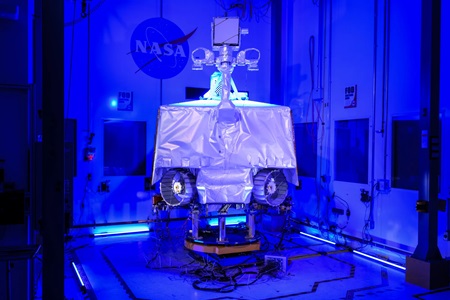
NASA has announced its decision to discontinue the development of the VIPER (Volatiles Investigating Polar Exploration Rover) project following an extensive internal review. The decision comes in response to escalating costs, delays to the launch date and the risks of further cost increases.
Originally slated for a late 2023 launch, the VIPER mission was delayed to late 2024 to allow more time for preflight testing of the Astrobotic lander. However, additional schedule and supply chain delays pushed the rover’s readiness date to September 2025. The associated CLPS (Commercial Lunar Payload Services) launch aboard Astrobotic’s Griffin lander also experienced similar delays. Continuing with VIPER would have resulted in increased costs that could threaten other CLPS missions.
Nicola Fox, Associate Administrator, Science Mission Directorate, NASA Headquarters in Washington, said: “We are committed to studying and exploring the Moon for the benefit of humanity through the CLPS program. The agency has an array of missions planned to look for ice and other resources on the Moon over the next five years. Our path forward will make maximum use of the technology and work that went into VIPER, while preserving critical funds to support our robust lunar portfolio.”
NASA plans to disassemble and reuse VIPER’s instruments and components for future Moon missions. Before disassembly, NASA will consider expressions of interest from US industry and international partners for the use of the existing VIPER rover system at no cost to the government.
Astrobotic will continue its Griffin Mission One under its contract with NASA, aiming for a launch no earlier than fall 2025. The mission, minus the VIPER rover, will serve as a flight demonstration for the Griffin lander and its engines.
NASA will pursue alternative methods to achieve many of VIPER’s objectives and verify the presence of ice at the lunar South Pole. A future CLPS delivery, the Polar Resources Ice Mining Experiment-1 (PRIME-1), is scheduled to land at the South Pole in the fourth quarter of 2024 to search for water ice and conduct a resource utilisation demonstration.
Additionally, future instruments as part of NASA’s crewed missions, such as the Lunar Terrain Vehicle, will enable mobile observations of volatiles across the south polar region and provide access for astronauts to permanently shadowed regions for sample return campaigns. NASA will also use copies of three of VIPER’s four instruments for future Moon landings on separate flights.
The VIPER rover was designed to search the Moon for ice and other potential resources, supporting NASA’s commitment to lunar exploration and unravelling the mysteries of the solar system.












Add Comment